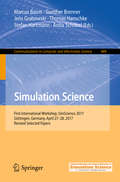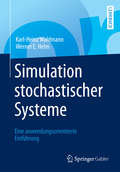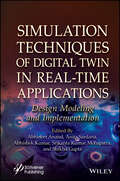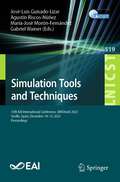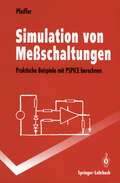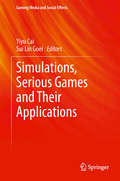- Table View
- List View
Simulation Science: First International Workshop, SimScience 2017, Göttingen, Germany, April 27–28, 2017, Revised Selected Papers (Communications in Computer and Information Science #889)
by Marcus Baum Gunther Brenner Jens Grabowski Thomas Hanschke Stefan Hartmann Anita SchöbelThis book constitutes the thoroughly refereed proceedings of the Clausthal-Göttingen International Workshop on Simulation Science, held in Göttingen, Germany, in April 2017. The 16 full papers presented were carefully reviewed and selected from 40 submissions. The papers are organized in topical sections on simulation and optimization in networks, simulation of materials, distributed simulations.
Simulation Science: Second International Workshop, SimScience 2019, Clausthal-Zellerfeld, May 8-10, 2019, Revised Selected Papers (Communications in Computer and Information Science #1199)
by Nina Gunkelmann Marcus BaumThis book constitutes the refereed proceedings of the Second International Workshop on Simulation Science, held in Clausthal-Zellerfeld, in May 2019. The 12 full papers were carefully reviewed and selected from 47 submissions. The papers are organized according to the following topics: optimization and distributed simulations; simulation of materials; self-organized and porous structures; simulation of materials: finite element and multiscale methods.
Simulation stochastischer Systeme: Eine anwendungsorientierte Einführung (PDF)
by Werner E. Helm Karl-Heinz WaldmannDas vorliegende Lehrbuch ist eine umfassende Einführung in die Simulation stochastischer Systeme. Auf 400 Seiten wird der Leser an stochastische Simulationsmodelle, Lösungsmethoden und statistische Analyseverfahren herangeführt. Die grundlegenden Sachverhalte werden ausführlich motiviert und begründet. Das Buch kann im Bachelor- und Masterbereich an Universitäten und Hochschulen eingesetzt werden. Untersuchungsgegenstand und Herangehensweise machen es interessant für Wirtschaftswissenschaftler, aber auch für Ingenieure, Mathematiker und Naturwissenschaftler. Vorausgesetzt werden die Grundbegriffe der Wahrscheinlichkeitsrechnung und elementaren Statistik; die tatsächlich benötigten Elemente werden im Anhang bereitgestellt. Das Buch ist stringent in der Darstellung. Es ermöglicht ‚Learning by Example‘ und ‚Learning by Doing‘ und kann zum Selbststudium verwendet werden. Jedes neue Konzept wird durch Beispiele, Abbildungen und Aufgaben begleitet, die ein schnelles Verstehen und Übertragen auf eigene Problemstellungen ermöglichen.
Simulation störanfälliger Systeme: Praxisorientierte Modelle und deren Einsatz auf Mikrocomputern zur betriebswirtschaftlichen Bewertung von Störungen komplexer Systeme (Bochumer Beiträge zur Unternehmensführung und Unternehmensforschung #29)
by Peter ChamoniSimulation Techniques of Digital Twin in Real-Time Applications: Design Modeling and Implementation
by Abhineet Anand Anita Sardana Abhishek Kumar Srikanta Kumar Mohapatra Shikha GuptaSIMULATION TECHNIQUES OF DIGITAL TWIN IN REAL-TIME APPLICATIONS The book gives a complete overview of implementing digital twin technology in real-time scenarios while emphasizing how this technology can be embedded with running technologies to solve all other issues. Divided into two parts with Part 1 focusing on simulated techniques in digital twin technology and Part 2 on real-time applications of digital twin technology, the book collects a significant number of important research articles from domain-specific experts. The book sheds light on the various techniques of digital twin technology that are implemented in various application areas. It emphasizes error findings and respective solutions before the actual event happens. Most of the features in the book are on the implementation of strategies in real-time applications. Various real-life experiences are taken to show the proper implementation of simulation technologies. The book shows how engineers of any technology can input their research ideas to convert to real scenarios by using replicas. Hence, the book has a collection of research articles from various engineers with expertise in different technologies from many regions of the world. It shows how to implement the embedded real-time data into technologies. Specifically, the chapters relate to the auto landing and cruising features in aerial vehicles, automated coal mining simulation strategy, the enhancement of workshop equipment, and implementation in power energy management for urban railways. This book also describes the coherent mechanism of digital twin technologies with deep neural networks and artificial intelligence. Audience Researchers, engineers, and students in computer science, software engineering and industrial engineering, will find this book to be very useful.
Simulation Techniques of Digital Twin in Real-Time Applications: Design Modeling and Implementation
by Abhishek Kumar Shikha Gupta Abhineet Anand Anita Sardana Srikanta Kumar MohapatraSIMULATION TECHNIQUES OF DIGITAL TWIN IN REAL-TIME APPLICATIONS The book gives a complete overview of implementing digital twin technology in real-time scenarios while emphasizing how this technology can be embedded with running technologies to solve all other issues. Divided into two parts with Part 1 focusing on simulated techniques in digital twin technology and Part 2 on real-time applications of digital twin technology, the book collects a significant number of important research articles from domain-specific experts. The book sheds light on the various techniques of digital twin technology that are implemented in various application areas. It emphasizes error findings and respective solutions before the actual event happens. Most of the features in the book are on the implementation of strategies in real-time applications. Various real-life experiences are taken to show the proper implementation of simulation technologies. The book shows how engineers of any technology can input their research ideas to convert to real scenarios by using replicas. Hence, the book has a collection of research articles from various engineers with expertise in different technologies from many regions of the world. It shows how to implement the embedded real-time data into technologies. Specifically, the chapters relate to the auto landing and cruising features in aerial vehicles, automated coal mining simulation strategy, the enhancement of workshop equipment, and implementation in power energy management for urban railways. This book also describes the coherent mechanism of digital twin technologies with deep neural networks and artificial intelligence. Audience Researchers, engineers, and students in computer science, software engineering and industrial engineering, will find this book to be very useful.
Simulation Technologies in Networking and Communications: Selecting the Best Tool for the Test
by Al-Sakib Khan Pathan Muhammad Mostafa Monowar Shafiullah KhanSimulation is a widely used mechanism for validating the theoretical models of networking and communication systems. Although the claims made based on simulations are considered to be reliable, how reliable they really are is best determined with real-world implementation trials.Simulation Technologies in Networking and Communications: Selecting th
Simulation Tools and Techniques: 13th EAI International Conference, SIMUtools 2021, Virtual Event, November 5-6, 2021, Proceedings (Lecture Notes of the Institute for Computer Sciences, Social Informatics and Telecommunications Engineering #424)
by Dingde Jiang Houbing SongThis proceedings constitutes the refereed post-conference proceedings of the 13th International Conference on Simulation Tools and Techniques, SIMUTools 2021, held in November 2021. Due to COVID-19 pandemic the conference was held virtually. The 63 revised full papers were carefully selected from 143 submissions. The papers focus on new results in the field of system modeling and simulation, software simulation, communication networks’ modeling and analysis, AI system simulation and performance analysis, big data simulation analysis, addressing current and future trends in simulation techniques. They are grouped in thematic aspects on wireless communication, big data, modeling and simulation, deep learning, network simulation and life and medical sciences.
Simulation Tools and Techniques: 15th EAI International Conference, SIMUtools 2023, Seville, Spain, December 14-15, 2023, Proceedings (Lecture Notes of the Institute for Computer Sciences, Social Informatics and Telecommunications Engineering #519)
by Agustín Riscos-Núñez José-Luis Guisado-Lizar María-José Morón-Fernández Gabriel WainerThis proceedings constitutes the refereed post-conference proceedings of the 15th International Conference on Simulation Tools and Techniques, SIMUTools 2023, held in Seville, Spain, in December 2023. The 23 revised full papers were carefully selected from 58 submissions. The papers focus on various areas such as Simulation Tools and Methods; Artificial Intelligence and Simulation; Transportation and Logistics; Medical Sciences; and Network Simulations.
Simulation Tools and Techniques: 11th International Conference, SIMUtools 2019, Chengdu, China, July 8–10, 2019, Proceedings (Lecture Notes of the Institute for Computer Sciences, Social Informatics and Telecommunications Engineering #295)
by Houbing Song Dingde JiangThis volume constitutes the refereed post-conference proceedings of the 11th International Conference on Simulation Tools and Techniques, SIMUTools 2019, held in Chengdu, China, in August 2019. The 97 revised full papers were carefully selected from 156 submissions. The papers focus on simulation methods, simulation techniques, simulation software, simulation performance, modeling formalisms, simulation verification and widely used frameworks.
Simulation Tools and Techniques: 12th EAI International Conference, SIMUtools 2020, Guiyang, China, August 28-29, 2020, Proceedings, Part II (Lecture Notes of the Institute for Computer Sciences, Social Informatics and Telecommunications Engineering #370)
by Houbing Song Dingde JiangThis two-volume set constitutes the refereed post-conference proceedings of the 12th International Conference on Simulation Tools and Techniques, SIMUTools 2020, held in Guiyang, China, in August 2020. Due to COVID-19 pandemic the conference was held virtually. The 125 revised full papers were carefully selected from 354 submissions. The papers focus on simulation methods, simulation techniques, simulation software, simulation performance, modeling formalisms, simulation verification and widely used frameworks.
Simulation Tools and Techniques: 12th EAI International Conference, SIMUtools 2020, Guiyang, China, August 28-29, 2020, Proceedings, Part I (Lecture Notes of the Institute for Computer Sciences, Social Informatics and Telecommunications Engineering #369)
by Houbing Song Dingde JiangThis two-volume set constitutes the refereed post-conference proceedings of the 12th International Conference on Simulation Tools and Techniques, SIMUTools 2020, held in Guiyang, China, in August 2020. Due to COVID-19 pandemic the conference was held virtually. The 125 revised full papers were carefully selected from 354 submissions. The papers focus on simulation methods, simulation techniques, simulation software, simulation performance, modeling formalisms, simulation verification and widely used frameworks.
Simulation Training: Improving Professional Practice Through Simulation Training
by Philippe Fauquet-Alekhine Nane PehuetDrawing on decades of industrial experience, this insightful and practical guide uses case studies and an interdisciplinary perspective to explain the fundamentals of simulation training to improve performance of high-risk professional activities. It seeks to identify those conditions under which simulation training has been shown to improve professional practice while employing extensive real examples. Simulation Training: Fundamentals and Application helps readers to develop their own synthesis of the simulation learning method and to use such training to enhance their skills and performance. Case studies demonstrate five specific theatres of professional practice - the nuclear-power industry, aeronautics, surgery, anesthesia and metallurgy – and then detailed analysis highlights the common factors and key results. The author’s background as a Human Factors Consultant, Physicist and Physiologist has enriched studies of humans in work situations, work organization and management and he has also been involved in pedagogical conception of experimental training on simulators based on his experience as a safety expert on nuclear power plant. The book is useful to practitioners, researchers and students, both in industry and in university. It is clearly cross disciplinary as it presents and discusses applications in engineering, professional practice (airline pilots) and medicine.
Simulation und moderne Programmiersprachen: Modula-2, C, Ada (Fachberichte Simulation #8)
by Bernd Page Rolf Bölckow Andreas Heymann Ralf Kadler Hansjörg LiebertSimulation und Optimierung in Produktion und Logistik: Praxisorientierter Leitfaden mit Fallbeispielen (VDI-Buch)
by Lothar März, Wilfried Krug, Oliver Rose and Gerald WeigertDie simulationsgestützte Optimierung von Produktportfolios und Produktionsketten birgt großes Potenzial – Berichte über Kopplungen von Simulation und Optimierung sind aber rar. Der Band liefert erstmals deutschsprachige Anwendungsbeispiele und einen Überblick über die Möglichkeiten von Simulation und Optimierung. Anders als standardisierte Planungsansätze können mithilfe der Simulation auch dynamische Produktions- und Logistikprozesse analysiert werden. Bei gezielter Vernetzung von Logistikabläufen lassen sich so unerwünschte Liegezeiten vermeiden.
Simulation von Meßschaltungen: Praktische Beispiele mit PSPICE berechnen (Springer-Lehrbuch)
by Wolfgang PfeifferDies ist ein Lehr- und Übungsbuch für die Simulation von elektrischen Schaltungen mit PSPICE, wie sie in der Vorlesung Meßtechnik für Studenten der Elektrotechnik an Hochschulen und Fachhochschulen behandelt werden. Die Grundvorlesungen über elektrische Meßtechnik müssen heutzutage verstärkt auf die Schaltungssimulation eingehen. Das Buch bearbeitet die für die Prüfung und Praxis wichtigsten und aktuellsten Schaltungsbeispiele in anschaulicher Darstellung, wobei auch jeweils die Codierungen in PSPICE mit angegeben werden. Dabei wird auf die Demonstration der typischen und wesentlichen Eigenschaften der Meßschaltungen besonderer Wert gelegt. Es ist sinnvoll und hilfreich, die Beispiele auf dem Rechner mit PSPICE nachzuvollziehen. Aber auch ohne diese Möglichkeit kann das Wesentliche über Meßschaltungen aus diesem Buch gelernt werden.
Simulation von Produktionssystemen
by Jan Kosturiak Milan GregorSeit einigen Jahren entwickelt sich Computersimulation zu einem unentbehrlichen Werkzeug in der Planung von Produktionssystemen, Unternehmenslogistik und Produktionsplanung und -steuerung. Systeme, die mit dieser Technik analysiert und gesteuert werden, wurden in den letzten Jahren stark verändert. Automatisierte, komplexe Produktionssysteme, dezentrale Organisationsstrukturen, schlanke Produktion und der "kontinuierliche Verbesserungsprozeß"in der Produktion - das alles stellt auch neue Anforderungen an die Simulationstechnik und ihre Benutzer. Das Buch führt in die Simulationstechnik und ihre theoretischen Grundlagen ein und gibt einen Überblick über Methodik und Anwendungen. Es dient Studenten als Lehrbuch und hilft Ingenieuren und Planern in Betrieben, die sich in die Thematik einarbeiten wollen.
Simulation von Röhrenverstärkern mit SPICE: PC-Simulationen von Elektronenröhren in Audioverstärkern
by Alexander PotchinkovAudio-Röhrenverstärker erfreuen sich wachsender Beliebtheit im Hochpreissegment. Die Verfügbarkeit moderner Bauelemente, neue Schaltungskonzepte und die Erfahrungen aus dem Transistorverstärkerbau lassen das Interesse an Neu- und Weiterentwicklungen von Röhrenverstärkern steigen. Elektronikentwicklung mit Hilfe des universellen Schaltungssimulationsprogramms SPICE bilden eine vollkommene Einheit. Das Buch, einzigartig in diesem Bereich, will die Entwickler und die zahlreichen Amateure mit SPICE zusammenbringen. Das Buch hat drei Schwerpunkte: die Modellierung von Verstärkerröhren, die Anwendung von SPICE für die Untersuchung von Schaltungskonzepten und die Vorstellung moderner Schaltungstechniken, die mit SPICE analysiert werden können.
Simulation with Python: Develop Simulation and Modeling in Natural Sciences, Engineering, and Social Sciences
by Rongpeng Li Aiichiro NakanoUnderstand the theory and implementation of simulation. This book covers simulation topics from a scenario-driven approach using Python and rich visualizations and tabulations. The book discusses simulation used in the natural and social sciences and with simulations taken from the top algorithms used in the industry today. The authors use an engaging approach that mixes mathematics and programming experiments with beginning-intermediate level Python code to create an immersive learning experience that is cohesive and integrated. After reading this book, you will have an understanding of simulation used in natural sciences, engineering, and social sciences using Python.What You'll LearnUse Python and numerical computation to demonstrate the power of simulationChoose a paradigm to run a simulationDraw statistical insights from numerical experimentsKnow how simulation is used to solve real-world problems Who This Book Is ForEntry-level to mid-level Python developers from various backgrounds, including backend developers, academic research programmers, data scientists, and machine learning engineers. The book is also useful to high school students and college undergraduates and graduates with STEM backgrounds.
Simulationen in BASIC mit dem IBM PC, XT, AT: Astronomie, Biologie, Chemie und Dokumentationen (Vieweg-Programmbibliothek Mikrocomputer #39)
by Martin StumppSimulanten sind uns als Menschen bekannt, die durch "vorgespielte" Symptome den Eindruck erwecken wollen, an einer bestimmten Krankheit zu leiden. Der Simulant besitztdaherdas wichtigste Merkmal für den naturwissenschaftlichen Begriff Simulation, bei dem ebenfalls in Modellspielen mit einfachen Spielregeln die Realität imitiert wird. Ein Modell ist immer durch die Anzahl seiner Parameter begrenzt, kann also niemals allgemeingültig sein. Ausgehend von leicht zu durchschauenden Modellen aus den Themenkreisen Astronomie, Biologie, Chemie und Dokumentation von Ergebnissen sollen 22 kleine Anwendungen mit GW-BASIC und Lotus 1-2-3 vorgestellt werden. Simulation soll hier als Hilfsmittel für die Erstellung von Prognosen oder einfachen Spiel ergebnissen von Modellen obiger Themenkreise verstanden werden. Natürlich stellt der Abstraktionsumfang eines jeden Modells den begrenzenden Faktor für die Anwendung im Schulbereich dar, da diese Fähigkeit zur Abstraktion alters- und schultypabhängig ist: Doch auch dort, wo die natürlichen Modelle (Versuchstiere) unersetzbar sind, unterstützt der PC das "Erlebnis" am Tierversuch, wenn er eine übersichtliche und schnelle Versuchs auswertung liefert. Daher ist auch ein Programm, welches Realwerte liefert, in die Samm lung der Simulationsprogramme mitaufgenommen worden.
Simulations as Scaffolds in Science Education (SpringerBriefs in Educational Communications and Technology)
by Maggie Renken Melanie Peffer Kathrin Otrel-Cass Isabelle Girault Augusto ChiocarrielloThis book outlines key issues for addressing the grand challenges posed to educators, developers, and researchers interested in the intersection of simulations and science education. To achieve this, the authors explore the use of computer simulations as instructional scaffolds that provide strategies and support when students are faced with the need to acquire new skills or knowledge. The monograph aims to provide insight into what research has reported on navigating the complex process of inquiry- and problem-based science education and whether computer simulations as instructional scaffolds support specific aims of such pedagogical approaches for students.
Simulations for Design and Manufacturing: Select Papers from AIMTDR 2016 (Lecture Notes on Multidisciplinary Industrial Engineering)
by Uday S. Dixit Ravi KantThis book focuses on numerical simulations of manufacturing processes, discussing the use of numerical simulation techniques for design and analysis of the components and the manufacturing systems. Experimental studies on manufacturing processes are costly, time consuming and limited to the facilities available. Numerical simulations can help study the process at a faster rate and for a wide range of process conditions. They also provide good prediction accuracy and deeper insights into the process. The simulation models do not require any pre-simulation, experimental or analytical results, making them highly suitable and widely used for the reliable prediction of process outcomes. The book is based on selected proceedings of AIMTDR 2016. The chapters discuss topics relating to various simulation techniques, such as computational fluid dynamics, heat flow, thermo-mechanical analysis, molecular dynamics, multibody dynamic analysis, and operational modal analysis. These simulation techniques are used to: 1) design the components, 2) to investigate the effect of critical process parameters on the process outcome, 3) to explore the physics of the process, 4) to analyse the feasibility of the process or design, and 5) to optimize the process. A wide range of advanced manufacturing processes are covered, including friction stir welding, electro-discharge machining, electro-chemical machining, magnetic pulse welding, milling with MQL (minimum quantity lubrication), electromagnetic cladding, abrasive flow machining, incremental sheet forming, ultrasonic assisted turning, TIG welding, and laser sintering. This book will be useful to researchers and professional engineers alike.
Simulations in Swift 5: Design and Implement with Swift Playgrounds
by Beau NouvelleDesign and implement simulations using Apples Swift Playgrounds. Computer simulations are used to replicate the physical systems we see all around us. They help us solve problems by performing experiments that may otherwise be impossible in the real world. This book uses simulations to solve counter-intuitive logic puzzles, create procedural artworks, and build habitats for digital lifeforms. To help you create your own simulations using the Swift programming language, this book is filled with projects that you can easily follow along with. All you need is a Mac with the latest version of Xcode installed. All projects are written in Xcode’s Playgrounds. This keeps the process simple. No need to setup an Apple account, or learn anything further about building apps.Simulations are used in many areas within computer science and yet, barely anyone is teaching them. Sure, the fundamentals are in algorithm design, but simulations are a step above that. Usually when writing an algorithm you have a specific outcome in mind. However, when you create a simulation, the system you are modelling can be far more unpredictable than sorting a list, or navigating a maze. Simulations in Swift 5 will guide you through all of this.What You'll LearnSimulate situations with advanced algorithms to solve advanced problemsIncorporate real-world physics into simulated problemsPredict biological and other systems behavior and the outcome of events based on presented factorsWho This Book Is ForSwift programmers interested in tackling fun projects in Swift involving advanced algorithms and factors
Simulations of Decision-Making as Active Learning Tools: Design and Effects of Political Science Simulations (Professional and Practice-based Learning #22)
by Peter Bursens Vincent Donche David Gijbels Pieter SpoorenThis volume brings together both political and educational scientists. While educational research literature has so far not systematically addressed the tool of simulations of decision-making, political scientists have hardly used insights from research on assessment or on motivation and interest of students. Almost all political science publications on simulations merely discuss how to implement the tool in class and fall short of providing evidence of the effects on student outcomes such as increased interest and performance. Combining the two disciplines is mutually enriching. Political science benefits from state of the art educational science measuring and testing of the claims made by the proponents of simulations, while educational sciences adds the systematic analysis of simulations of decision-making to their list of empirical objects, which also adds insights to the theories on the affective component of student learning. It is the explicit aim of the volume to address how simulating decision-making environments fosters learning. Implications for research and practice regarding student learning are addressed in all chapters.
Simulations, Serious Games and Their Applications (Gaming Media and Social Effects)
by Yiyu Cai Sui Lin GoeiThis book presents the state of the art technology in Serious Games which is driven extensive by applications and research in simulation. The topics in this book include: (1) Fashion simulation; (2) Chinese calligraphy ink diffusion simulation; (3) Rehabilitation (4) Long vehicle turning simulation; (5) Marine traffic conflict control; (6) CNC simulation; (7) Special needs education. The book also addresses the fundamental issues in Simulation and Serious Games such as rapid collision detection, game engines or game development platforms. The target audience for this book includes scientists, engineers and practitioners involved in the field of Serious Games and Simulation. The major part of this book comprises of papers presented at the 2012 Asia-Europe Workshop on Serious Games and Simulation held in Nanyang Technological University, Singapore (May 9, 2012). All the contributions have been peer reviewed and by scientific committee members with report about quality, content and originality.
